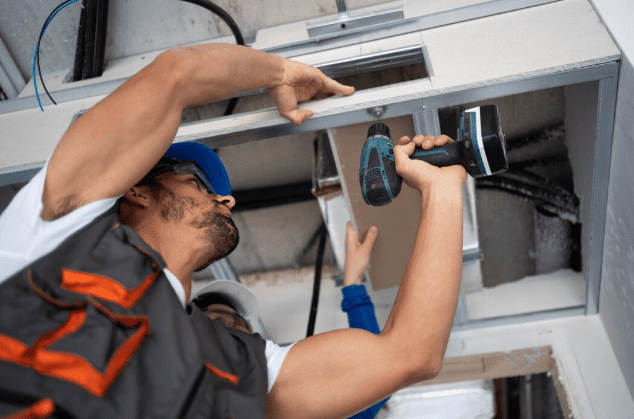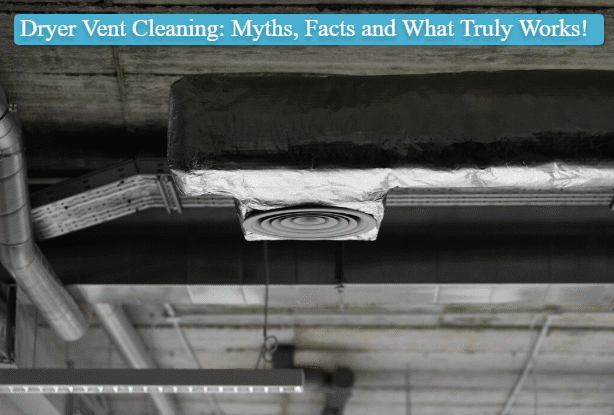Dryer Vent Cleaning Myths And Facts Home Edition
We hear wild stories about dryer vent maintenance every week. Some are half true. Some are just plain wrong. Suppose you are a homeowner trying to keep laundry day safe, fast, and affordable. Cutting through the noise matters. In this guide, we bust the biggest myths we see online and in houses across our service area, and we back them up with what we see on real jobs. By the end, you will know which habits actually help, when to use DIY, and when to call for professional dryer vent cleaning service so you can protect your dryer, your energy bill, and your peace of mind.
We will keep this simple, friendly, and practical. No scare tactics. Just clear facts, smart tips, and easy habits that work.
Myth 1: “I Clean The Lint Screen, So My Dryer Vent Is Fine”
The lint screen is essential, but it is not the whole story. Some fibers always bypass the screen and cling to elbows, seams, and low spots in the dryer vent. Over time, airflow slows, heat rises, and dry times creep up. You still need to routinely clean your dryer vent even if you never skip the lint screen.
Facts to remember
- Keep cleaning the dryer lint trap before every load to cut lint at the source.
- Step outside during a heat cycle once a month and check that the exterior dryer vent hood flap opens fully.
- If dry times stretch or the cabinet runs hot, schedule cleaning your dryer vents first, then recheck performance.
Myth 2: “If Air Is Coming Out, The Dryer Vent Is Not Clogged”
A partially blocked dryer vent still blows air. It just does it poorly. That restriction makes the dryer work harder and longer, which costs money and wears parts. One of the fastest wins you can get is a full-path dryer vent cleaning that clears elbows and compacted lint you cannot reach from the wall.
Quick checks
- Outside, the exterior dryer vent flap should swing wide with steady force.
- Indoors, if towels need two cycles, the dryer vent airflow is likely restricted.
- A toasty smell at the end of a cycle means the system is running hotter than it should.
Myth 3: “My Dryer Vent Is Short, So It Never Needs Cleaning”
Short dryer vent runs clog more slowly, not never. Heavy lint loads, pets, and fabric softener residue speed buildup. A brief, crushed dryer vent connector can clog faster than a long, well-installed run. If you see lint dust behind the dryer or the exterior dryer vent flap barely opens, it is time to clean the dryer vent, even if the run is only a few feet.
What we see most
- Crushed foil dryer vent connectors behind the dryer that act like a lint trap
- Painted exterior dryer vent hoods that stick shut and stall airflow
- Low spots that create lint pockets, even on short dryer vent runs
Myth 4: “DIY Is Always Enough”
DIY helps when the dryer vent path is short and straight, and both ends are easy to reach. Most clogs hide in elbows and long horizontal runs. That is when a professional dryer vent cleaning visit with rotary brushes and strong capture makes all the difference.
DIY is reasonable when
- You can safely pull the dryer out and access both dryer vent ends
- You have the right brush size and a solid vacuum
- You reassemble with a rigid or semi-rigid metal dryer vent connector, not flimsy foil
Hire a pro when
- The exterior dryer vent termination is high or on a roof
- The dryer vent has multiple bends or runs through an attic or crawl space
- Dry times stay long after your first pass
Myth 5: “All Dryer Vent Cleaning Companies Do The Same Thing”

Methods vary a lot. The best dryer vent cleaning companies clean the entire dryer vent path, prove airflow at the end, and correct unsafe dryer vent connectors. Quick, cheap sweeps often vacuum only at the wall and skip elbows and the exterior dryer vent hood. Reading real dryer vent cleaning reviews makes the difference between a quick dust off and a proper clear out.
What a quality visit includes
- Route inspection, counted elbows, and took photos of the dryer vent path
- Full-path brushing and vacuum capture inside the dryer vent
- Exterior dryer vent hood cleaning and flap test outdoors
- Reconnect with safe dryer vent materials and proper clearance
- Airflow verification with you present at the exterior dryer vent
Choose teams known for friendly dryer vent cleaning that explain their process and show before and after proof.
Myth 6: “If I Smell Odor, It Is Always Plumbing”
A drain trap can cause sewer smells, but laundry odors are often dryer vent airflow problems. Lingering moisture and lint film in the dryer vent create stale, musty notes, and weak exhaust can back warm air into the room. Clearing the dryer vent path and keeping the exterior dryer vent hood moving freely are the fastest odor fixes, right alongside basic housekeeping.
Odor basics
- Musty towels and a humid laundry room usually point to dryer vent airflow restrictions
- A sharp gas smell is an emergency; leave and call your utility
- After the dryer vent is cleared, fabrics often need one or two fresh cycles to release residual odor
Myth 7: “Foil Connectors Are Fine If I Don’t Crush Them”
Foil accordion dryer vent connectors are fragile and rough inside, which traps lint. A rigid or semi-rigid metal dryer vent connector with smooth interior walls protects airflow and resists crushing when you slide the dryer back. This small upgrade during the cleaning of dryer vents pays off every single load.
Connector rules
- Maintain four to six inches of space behind the dryer for the dryer vent connector
- Replace plastic or thin foil with rigid or semi-rigid metal dryer vent materials
- Keep the dryer vent path as straight as possible to reduce friction
Myth 8: “New Dryers Don’t Need Dryer Vent Service”
New machines still shed lint. In fact, strong modern blowers can pack lint into dryer vent elbows even faster. A clear dryer vent keeps a new dryer efficient and quiet. Start your ownership with a clean dryer vent, then maintain a simple routine so you do not lose performance.
Smart new-owner routine
- Lint screen every load for the dryer vent system’s sake
- Monthly exterior dryer vent flap check
- Annual dryer vent clear for average households or sooner for long, bendy runs
Myth 9: “It’s Too Expensive To Call A Pro”

A properly cleaned dryer vent can pay for itself by cutting run time and protecting parts. Long cycles add up on your utility bill, and repeated heat stress shortens element and sensor life. When you compare quotes, look for scope and proof, not just the lowest number. The value of Companies that clean dryer vents with full-path dryer vent results is immediate on your very next load.
What you are paying for
- Trained techs, safe dryer vent disconnection and reassembly
- Rotary agitation matched to your dryer vent duct size
- Strong capture to keep dust out of the home during dryer vent cleaning
- Corrections to unsafe dryer vent connectors and stuck exterior hoods
- Photo evidence and an airflow demo at the exterior dryer vent at the end
Ready For Faster, Safer Laundry Days: Book A Full-Path Dryer Vent Cleaning
If your cycles are dragging or the cabinet runs hot, do not wait. Schedule professional dryer vent cleaning service with a team that will clean out a dryer vent completely and make it easy to keep clear. We deliver careful, friendly dryer vent cleaning, honest advice, and proof you can see. If you are comparing dryer vent cleaning companies, ask for a scope, photos, and an airflow check. We are happy to show our work on every visit. Call Mighty Ducts of Texas for a free consultation and to schedule your dryer vent inspection and cleaning today!

